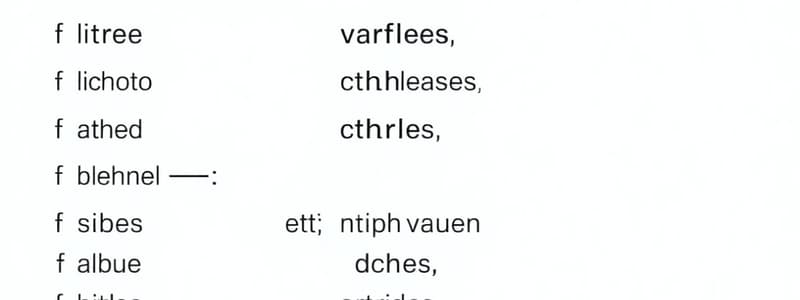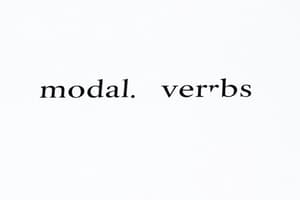Podcast
Questions and Answers
Which of the following verbs is NOT typically categorized as a modal auxiliary verb?
Which of the following verbs is NOT typically categorized as a modal auxiliary verb?
- Could
- Seem (correct)
- Must
- Should
In 'other verb + verb' structures, questions and negatives are formed without the use of 'do'.
In 'other verb + verb' structures, questions and negatives are formed without the use of 'do'.
False (B)
Provide an example of a sentence using a 'modal auxiliary verb'.
Provide an example of a sentence using a 'modal auxiliary verb'.
You must call Uncle Arthur.
The verbs will, shall, would, should, can, could, may, might, must and ought are usually called '______'.
The verbs will, shall, would, should, can, could, may, might, must and ought are usually called '______'.
Match the verb structures with the correct examples:
Match the verb structures with the correct examples:
Which of the following best describes the role of the first verb in a 'verb + verb' structure?
Which of the following best describes the role of the first verb in a 'verb + verb' structure?
It is grammatically correct to say 'We seem having a problem.'
It is grammatically correct to say 'We seem having a problem.'
Provide an example of a sentence with a 'chain' of verbs.
Provide an example of a sentence with a 'chain' of verbs.
Many verbs besides auxiliaries can be followed by forms of other verbs (or by structures including other verbs). This can happen, for example, if we talk about our ______ to an action.
Many verbs besides auxiliaries can be followed by forms of other verbs (or by structures including other verbs). This can happen, for example, if we talk about our ______ to an action.
Match the sentence with its correct verb structure explanation:
Match the sentence with its correct verb structure explanation:
In the sentence, 'We all want you to be happy', which structure is used?
In the sentence, 'We all want you to be happy', which structure is used?
The sentence 'We all want that you are happy' is grammatically correct.
The sentence 'We all want that you are happy' is grammatically correct.
Give an example of a sentence using the structure 'verb + object + verb'.
Give an example of a sentence using the structure 'verb + object + verb'.
Many verbs can be followed by an ______ as well as a verb structure.
Many verbs can be followed by an ______ as well as a verb structure.
Match the examples with the correct 'be' verb form:
Match the examples with the correct 'be' verb form:
Which of the following sentences correctly uses the progressive form of the linking verb 'be'?
Which of the following sentences correctly uses the progressive form of the linking verb 'be'?
Questions and negatives with the verb 'be' are typically formed using the auxiliary 'do'.
Questions and negatives with the verb 'be' are typically formed using the auxiliary 'do'.
Provide an example of negative imperative sentence using 'be'.
Provide an example of negative imperative sentence using 'be'.
Normally, 'be' is used without the auxiliary ______.
Normally, 'be' is used without the auxiliary ______.
Match the sentences with the correct 'be' verb use:
Match the sentences with the correct 'be' verb use:
Which of the following sentences uses the be: progressive forms correctly?
Which of the following sentences uses the be: progressive forms correctly?
Be is normally used with the auxiliary do.
Be is normally used with the auxiliary do.
What three verbs live a double life?
What three verbs live a double life?
These three verbs live a double life. They can be ______ verbs used to form questions, negatives, emphatic forms, perfect and progressive tenses, and passives. Be can also be a linking verb, and have and do can be ordinary full verbs.
These three verbs live a double life. They can be ______ verbs used to form questions, negatives, emphatic forms, perfect and progressive tenses, and passives. Be can also be a linking verb, and have and do can be ordinary full verbs.
Match each verb with its structure that it is used in:
Match each verb with its structure that it is used in:
Flashcards
Modal Auxiliary Verbs
Modal Auxiliary Verbs
Verbs like 'will', 'shall', 'can', 'may', etc., used with other verbs to add meaning, mostly certainty or obligation.
Other Verb + Verb Structures
Other Verb + Verb Structures
Verbs like 'seem' used in verb + verb structures, differing grammatically from auxiliary verbs; require 'do' in questions/negatives.
Verb + Verb Structures
Verb + Verb Structures
Using infinitives, -ing forms, or clauses after verbs to describe attitudes or actions.
Verb + Object + Verb
Verb + Object + Verb
Signup and view all the flashcards
'Be', 'Have', and 'Do'
'Be', 'Have', and 'Do'
Signup and view all the flashcards
The verb 'Be'
The verb 'Be'
Signup and view all the flashcards
'Be' in Progressive Forms
'Be' in Progressive Forms
Signup and view all the flashcards
'Be' with Auxiliary 'Do'
'Be' with Auxiliary 'Do'
Signup and view all the flashcards
Study Notes
Modal Auxiliary Verbs
- Verbs like will, shall, would, should, can, could, may, might, must, and ought are modal auxiliary verbs
- They modify other verbs, adding meanings of certainty or obligation
Other Verb + Verb Structures
- Some verbs (e.g., seem) in verb + verb structures aren't auxiliary verbs
- Auxiliary verbs form questions/negatives without do
- Other verb structures require do to be added to the first verb
Verb + Verb: Other Structures
- Verbs, other than auxiliaries, can be followed by other verb forms or structures
- The first verb often describes an attitude, and the second refers to the action
- The second verb acts like the direct object
- Structures vary: infinitives (with/without to), -ing forms (with/without a preposition), and clauses
- The structure used depends on the specific verb
- Some verbs allow multiple structures, changing the meaning
Verb + Object + Verb
- Verbs can be followed by an object and another verb structure
Introduction to Be, Have, and Do
- These verbs have dual functions
- They act as auxiliary verbs in questions, negatives, emphatic forms, perfect and progressive tenses, and passives
- They also function as linking verbs (be) or ordinary full verbs (have, do)
- It is possible for them to appear twice in a single phrase
Be: General
- Be functions as an auxiliary verb in progressive and passive structures
- It also acts as a linking verb, connecting a subject to a complement
- Progressive forms of linking verbs are uncommon, but possible
- Questions and negatives with be don't use do, except for emphatic or negative imperative sentences
Be: Progressive Forms
- The structure I am being / you are being, etc + adjective/noun describes temporary actions/behaviors
- It's not typically used for feelings
- He's being sick means he is vomiting, while He's sick means he is ill
Be with Auxiliary Do
- Be generally doesn't need auxiliary do
- Do is used to form negative imperative sentences with be
Studying That Suits You
Use AI to generate personalized quizzes and flashcards to suit your learning preferences.




